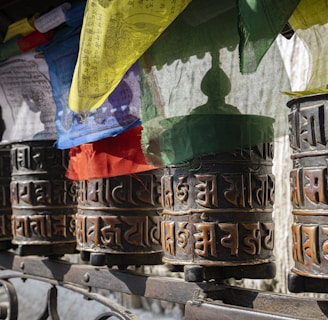
Buddhism in Southeast Asia: Variants & Orientations
11/2/2024
Traditions and Practices in Southeast Asia: Buddhism in its Diverse Traditions.
Buddhism is pervasive throughout Southeast Asia, inseparable from the cultural, social and even political life of Thailand, Myanmar, Laos, Cambodia and Vietnam. As a tradition, it’s been here since more than 2,000 years and Buddhism there has continued to adapt and evolve into new styles and practices. Theravda Buddhism is omnipresent, but also Mahyna and Vajrayna Buddhism are practised here, and the spiritual terrain in the region is rich. In this article, we will see what the various Buddhist traditions of Southeast Asia look like, their orientation, and how they inform the lives of millions of adherents.
1. Theravda Buddhism: The Core of Southeast Asian Religion — By the author.
This is the largest religion in Southeast Asia – specifically Thailand, Myanmar, Cambodia and Laos – Theravda Buddhism or "Doctrine of the Elders". According to the Pli Canon, it emphasizes private knowledge, meditation and mindfulness as methods of enlightenment. Theravda devotees often look to the Buddha’s early teachings, who explained the path to enlightenment as one of discipline, virtue and knowledge.
For monks (bhikkhus) in these nations, it’s a big deal. Ordination is regarded as a sort of passage and most men are ordained at some point. Monks are at the centre of society, offering advice, leading rituals and blessings. Their existence emphasises the cultural value of Buddhism – particularly in rural communities where temples serve as community centres. Theravda practices are often crude and solemn, concerned with merit-creation, whether it’s distributing food to monks or celebrating uposatha (holy days), in which non-clergy earn good karma.
2. Mahayna Buddhism: Compassion and the Bodhisattva Way
Theravda dominates, but there is Mahyna Buddhism also present, especially in Vietnam and areas of Malaysia and Singapore where large populations of Chinese or Vietnamese descent have preserved these traditions. Mahyna or the "Great Vehicle" views enlightenment in broader terms, namely the Bodhisattva path, wherein practitioners wish to be enlightened not only for themselves but for all sentient beings. It is the branch that emphasises mercy (karu) as the supreme virtue, and which doesn’t emphasise monastic life as much as Theravda.
Intense rituals and flamboyant effigies of various Buddhas and Bodhisattvas, such as Avalokitevara (Guanyin, in Chinese) characterise Mahyna temples. Chanting, prayer wheels and the burning of incense – offerings to the enlightened – are religious rituals in Mahyna. This tradition appeals to Southeast Asians interested in collective cults and who find inspiration in a more interdependent ideal of liberation.
3. Vajrayna Affects: The Reign of Tibetan Buddhism
Vajrayna (meaning "Diamond Vehicle") Buddhism is not widespread, but does exist in northern Vietnam and Thailand. Tibetan refugees have imported Vajrayna practices – an amalgam of occult practices, visualization, mantra and meditative practices – that are peculiar to the practice. Some Theravda monasteries in Thailand even hosted Vajrayna practices, and those seeking Tantric techniques were scouted out as an added practice to the Theravda system.
Temples and practitioners of Vajrayna give Southeast Asia’s religious scene a more exotic feel, where emphasis is usually placed on direct experience, on transforming the ‘strange state’ of mind into wisdom and compassion. Despite being different from the less sophisticated Theravda, Vajrayna appeals to seekers of a mystical Buddhism.
4. Animism and Folk Traditions: Community Messages and Ideas
Something else that makes Buddhism important in Southeast Asia is its relation to animist theory and folk practices. Buddhism has been well-integrated with other existing forms of belief in spirits, ancestralism and animalism in most Southeast Asian communities. In Thailand and Myanmar, for example, they might construct spirit houses outside homes or offices, feeding local spirits – nats in Myanmar or phi in Thailand – with food and incense. Such rituals are not Buddhist per se, but go hand-in-hand with Buddhist rites and sometimes in temples themselves, emblematic of the syncretic spirit of Southeast Asian culture.
Buddhism in Southeast Asia is uniquely mixed with this Buddhist-folk ideology. With a combination of Buddhist practices and local spirits ritual, people create a new religion, in which monks can bless homes or pacify spirits, and sacred rituals might integrate Buddhist chants with local dances.
5. Avant-Garde Buddhism: Social Interactions and Reformations.
The present Southeast Asia is a mix of the ancient and the modern, and Buddhism was influential in matters of socio-political concern. Then in the past few decades there have been movements such as Engaged Buddhism – social action and justice based on Buddhist philosophies – particularly in Thailand and Myanmar. It also appeals to younger seekers who are inspired to think of Buddhism as more than an individual quest for self-realisation but a way of working out solutions for social, economic and environmental problems.
As Southeast Asian Buddhists grow more global, so too do new ideas and technologies. Temples have sermons streaming online, meditation apps are catching on, and social media is a venue for spiritual teachers. Such contemporary reforms make Buddhism more available to the urban, technocratish population, but also present problems to traditional tradition.
Sources
1. Strong, J. S. (1995). The Buddhist Experience: Causes and Contexts. Belmont, CA: Wadsworth Publishing.
2. Keyes, C. F. (1993). Buddhism and Ethnicity: Social Organisation and Identity in Southeast Asia. The Journal of Asian Studies, 52(3), 741-765.
3. Swearer, D. K. (2010). The Buddhist World of Southeast Asia. Albany, NY: State University of New York Press.
4. Harvey, P. (2013). A Short Introduction to Buddhism: Principles, Tradition and Instruction. Cambridge: Cambridge University Press.
5. Berkwitz, S. C. (2006). Buddhism in World Cultures: Comparative Studies. Santa Barbara, CA: ABC-CLIO.
Southeast Asian Buddhism is a patchwork quilt, a mixture of ancient texts, regional practices, new roles, and new translations. Between the Theravda and the Mahyna, the Vajrayna and the indigenous spirituality, the region’s Buddhist traditions exhibit a particular form of spirituality that is still developing, and that resonates with millions of people across cultures.














